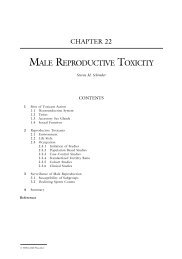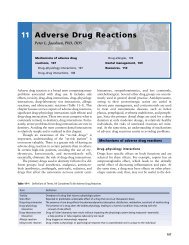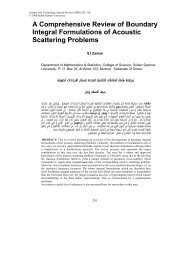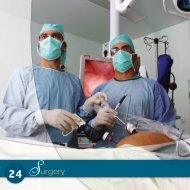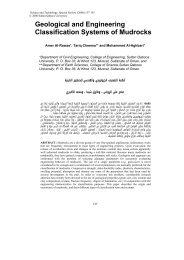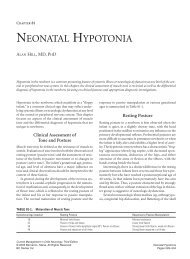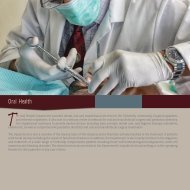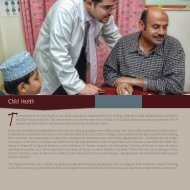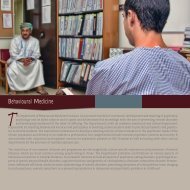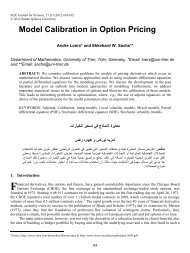Ch05: Red and White Lesions of the Oral Mucosa
Ch05: Red and White Lesions of the Oral Mucosa
Ch05: Red and White Lesions of the Oral Mucosa
You also want an ePaper? Increase the reach of your titles
YUMPU automatically turns print PDFs into web optimized ePapers that Google loves.
<strong>Red</strong> <strong>and</strong> <strong>White</strong> <strong>Lesions</strong> <strong>of</strong> <strong>the</strong> <strong>Oral</strong> <strong>Mucosa</strong> 87<br />
FEATURES<br />
The oral lesions are similar to those <strong>of</strong> WSN, with thick, corrugated,<br />
asymptomatic, white “spongy” plaques involving <strong>the</strong><br />
buccal <strong>and</strong> labial mucosa. O<strong>the</strong>r intraoral sites include <strong>the</strong> floor<br />
<strong>of</strong> <strong>the</strong> mouth, <strong>the</strong> lateral tongue, <strong>the</strong> gingiva, <strong>and</strong> <strong>the</strong> palate. The<br />
oral lesions are generally detected in <strong>the</strong> first year <strong>of</strong> life <strong>and</strong><br />
gradually increase in intensity until <strong>the</strong> teens. The most significant<br />
aspect <strong>of</strong> HBID involves <strong>the</strong> bulbar conjunctiva, where<br />
thick, gelatinous, foamy, <strong>and</strong> opaque plaques form adjacent to<br />
<strong>the</strong> cornea. The ocular lesions manifest very early in life (usually<br />
within <strong>the</strong> first year). Some patients exhibit chronic relapsing<br />
ocular irritation <strong>and</strong> photophobia. The plaques may exhibit<br />
seasonal prominence, with many patients reporting more-pronounced<br />
lesions in <strong>the</strong> spring <strong>and</strong> regression during <strong>the</strong> summer<br />
months. A few cases <strong>of</strong> blindness due to corneal vascularization<br />
following HBID have been reported. 12 The<br />
histopathologic features <strong>of</strong> HBID are characteristic, <strong>and</strong> <strong>the</strong><br />
epi<strong>the</strong>lium exhibits marked parakeratin production with thickening<br />
<strong>of</strong> <strong>the</strong> stratum spinosum <strong>and</strong> <strong>the</strong> presence <strong>of</strong> numerous<br />
dyskeratotic cells. Ultrastructural findings in patients with<br />
HBID reveal <strong>the</strong> <strong>the</strong> presence <strong>of</strong> numerous vesicular bodies in<br />
immature dyskeratotic cells, densely packed ton<strong>of</strong>ilaments<br />
within <strong>the</strong> cytoplasm <strong>of</strong> <strong>the</strong>se cells, <strong>and</strong> <strong>the</strong> disappearance <strong>of</strong><br />
cellular bridging in mature dyskeratotic cells. 14<br />
TREATMENT<br />
Since HBID is a benign condition, no treatment is required for<br />
<strong>the</strong> oral lesions. For evaluation <strong>and</strong> treatment <strong>of</strong> <strong>the</strong> ocular<br />
lesions, <strong>the</strong> patient should be referred to an ophthalmologist. 12<br />
Dyskeratosis Congenita<br />
Dyskeratosis congenita, a recessively inherited genodermatosis, is<br />
unusual due to <strong>the</strong> high incidence <strong>of</strong> oral cancer in young affected<br />
adults. 15 It is a rare X-linked disorder characterized by a series <strong>of</strong><br />
oral changes that lead eventually to an atrophic leukoplakic oral<br />
mucosa, with <strong>the</strong> tongue <strong>and</strong> cheek most severely affected. 15 The<br />
oral changes occur in association with severely dystrophic nails<br />
<strong>and</strong> a prominent reticulated hyperpigmentation <strong>of</strong> <strong>the</strong> skin <strong>of</strong> <strong>the</strong><br />
face, neck, <strong>and</strong> chest. 15 Many cases also exhibit hematologic<br />
changes including pancytopenia, hypersplenism, <strong>and</strong> an aplastic<br />
or Fanconi’s anemia (ie, an anemia associated with an inherited<br />
inability to repair deoxyribonucleic acid [DNA] defects, leading<br />
to a high frequency <strong>of</strong> leukemia <strong>and</strong> lymphoma). 16,17<br />
The oral lesions commence before <strong>the</strong> age <strong>of</strong> 10 years as<br />
crops <strong>of</strong> vesicles with associated patches <strong>of</strong> white ulcerated<br />
necrotic mucosa <strong>of</strong>ten infected with C<strong>and</strong>ida. Erythroplakic<br />
changes <strong>and</strong> nail dystrophy follow, with leukoplakic lesions <strong>and</strong><br />
carcinoma supervening on <strong>the</strong> oral lesions in early adulthood. 15<br />
▼ REACTIVE AND INFLAMMATORY<br />
WHITE LESIONS<br />
Linea Alba (<strong>White</strong> Line)<br />
As <strong>the</strong> name implies, linea alba is a horizontal streak on <strong>the</strong><br />
buccal mucosa at <strong>the</strong> level <strong>of</strong> <strong>the</strong> occlusal plane extending from<br />
<strong>the</strong> commissure to <strong>the</strong> posterior teeth. It is a very common<br />
finding <strong>and</strong> is most likely associated with pressure, frictional<br />
irritation, or sucking trauma from <strong>the</strong> facial surfaces <strong>of</strong> <strong>the</strong><br />
teeth. This alteration was present in about 13% <strong>of</strong> <strong>the</strong> population<br />
in one study. 18–20<br />
CLINICAL FEATURES<br />
Linea alba is usually present bilaterally <strong>and</strong> may be pronounced<br />
in some individuals. It is more prominent in individuals<br />
with reduced overjet <strong>of</strong> <strong>the</strong> posterior teeth. It is <strong>of</strong>ten<br />
scalloped <strong>and</strong> restricted to dentulous areas. 18<br />
TREATMENT<br />
No treatment is indicated for patients with linea alba. The<br />
white streak may disappear spontaneously in some people. 18,19<br />
Frictional (Traumatic) Keratosis<br />
CLINICAL FEATURES<br />
Frictional (traumatic) keratosis is defined as a white plaque<br />
with a rough <strong>and</strong> frayed surface that is clearly related to an<br />
identifiable source <strong>of</strong> mechanical irritation <strong>and</strong> that will usually<br />
resolve on elimination <strong>of</strong> <strong>the</strong> irritant. These lesions may<br />
occasionally mimic dysplastic leukoplakia; <strong>the</strong>refore, careful<br />
examination <strong>and</strong> sometimes a biopsy are required to rule out<br />
any atypical changes. 20,21 Histologically, such lesions show<br />
varying degrees <strong>of</strong> hyperkeratosis <strong>and</strong> acanthosis. 22 Prevalence<br />
rates as high as 5.5% have been reported. 21 Such lesions are<br />
similar to calluses on <strong>the</strong> skin. Traumatic keratosis has never<br />
been shown to undergo malignant transformation. 23 <strong>Lesions</strong><br />
belonging to this category <strong>of</strong> keratosis include linea alba <strong>and</strong><br />
cheek, lip, <strong>and</strong> tongue chewing. Frictional keratosis is frequently<br />
associated with rough or maladjusted dentures (Figure<br />
5-2) <strong>and</strong> with sharp cusps <strong>and</strong> edges <strong>of</strong> broken teeth. 20<br />
TREATMENT<br />
Upon removal <strong>of</strong> <strong>the</strong> <strong>of</strong>fending agent, <strong>the</strong> lesion should resolve<br />
within 2 weeks. Biopsies should be performed on lesions that<br />
do not heal to rule out a dysplastic lesion.<br />
FIGURE 5-2 Leukoplakic-appearing area <strong>of</strong> frictional keratosis from an<br />
ill-fitting denture.





